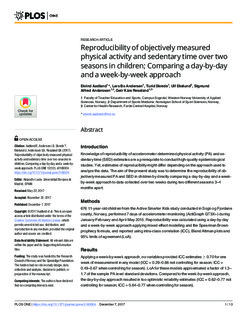| dc.contributor.author | Aadland, Eivind | |
| dc.contributor.author | Andersen, Lars Bo | |
| dc.contributor.author | Skrede, Turid | |
| dc.contributor.author | Ekelund, Ulf | |
| dc.contributor.author | Anderssen, Sigmund Alfred | |
| dc.contributor.author | Resaland, Geir Kåre | |
| dc.date.accessioned | 2018-05-23T10:41:19Z | |
| dc.date.available | 2018-05-23T10:41:19Z | |
| dc.date.created | 2018-01-23T20:57:06Z | |
| dc.date.issued | 2017 | |
| dc.identifier.citation | PLoS ONE. 2017, 12, e0189304. | |
| dc.identifier.issn | 1932-6203 | |
| dc.identifier.uri | http://hdl.handle.net/11250/2498864 | |
| dc.description | This is an open access article distributed under the terms of the Creative Commons Attribution License, which permits unrestricted use, distribution, and reproduction in any medium, provided the original author and source are credited. | |
| dc.description.abstract | Introduction: Knowledge of reproducibility of accelerometer-determined physical activity (PA) and sedentary time (SED) estimates are a prerequisite to conduct high-quality epidemiological studies. Yet, estimates of reproducibility might differ depending on the approach used to analyze the data. The aim of the present study was to determine the reproducibility of objectively measured PA and SED in children by directly comparing a day-by-day and a week-by-week approach to data collected over two weeks during two different seasons 3–4 months apart.
Methods: 676 11-year-old children from the Active Smarter Kids study conducted in Sogn og Fjordane county, Norway, performed 7 days of accelerometer monitoring (ActiGraph GT3X+) during January-February and April-May 2015. Reproducibility was calculated using a day-by-day and a week-by-week approach applying mixed effect modelling and the Spearman Brown prophecy formula, and reported using intra-class correlation (ICC), Bland Altman plots and 95% limits of agreement (LoA).
Results: Applying a week-by-week approach, no variables provided ICC estimates ≥ 0.70 for one week of measurement in any model (ICC = 0.29–0.66 not controlling for season; ICC = 0.49–0.67 when controlling for season). LoA for these models approximated a factor of 1.3–1.7 of the sample PA level standard deviations. Compared to the week-by-week approach, the day-by-day approach resulted in too optimistic reliability estimates (ICC = 0.62–0.77 not controlling for season; ICC = 0.64–0.77 when controlling for season).
Conclusions: Reliability is lower when analyzed over different seasons and when using a week-by-week approach, than when applying a day-by-day approach and the Spearman Brown prophecy formula to estimate reliability over a short monitoring period. We suggest a day-by-day approach and the Spearman Brown prophecy formula to determine reliability be used with caution. | |
| dc.language.iso | eng | |
| dc.subject | physical activity | |
| dc.subject | research validity | |
| dc.subject | seasons | |
| dc.subject | accelerometers | |
| dc.subject | exercise | |
| dc.subject | reproducibility | |
| dc.subject | children | |
| dc.subject | seasonal variations | |
| dc.title | Reproducibility of objectively measured physical activity and sedentary time over two seasons in children; Comparing a day-by-day and a week-by-week approach | |
| dc.type | Peer reviewed | |
| dc.type | Journal article | |
| dc.description.version | publishedVersion | |
| dc.rights.holder | © 2017 Aadland et al. | |
| dc.source.volume | 12 | |
| dc.source.journal | PLoS ONE | |
| dc.source.issue | 12 | |
| dc.identifier.doi | 10.1371/journal.pone.0189304 | |
| dc.identifier.cristin | 1550401 | |
| dc.description.localcode | Seksjon for idrettsmedisinske fag / Department of Sports Medicine | |
| cristin.unitcode | 150,34,0,0 | |
| cristin.unitname | Seksjon for idrettsmedisinske fag | |
| cristin.ispublished | true | |
| cristin.fulltext | original | |
| cristin.qualitycode | 1 | |
